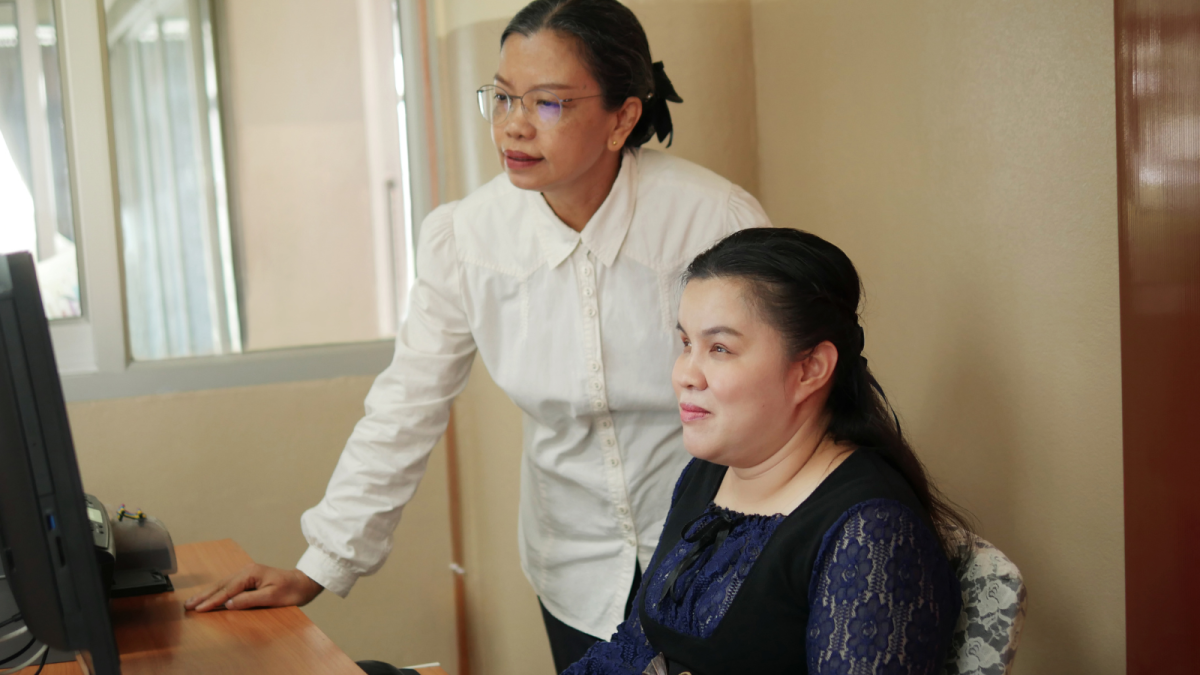A round-up, if you have missed them!

Image: Two women are at a desk looking at a computer. A woman in a white shirt is standing and a woman in a dark shirt is sitting. The woman in the dark shirt has a vision impairment and is using a screen reader.
As a provider of disability services and an inclusive employer, we care about accessibility and have our fingers on the pulse of new features. Here are a few new accessibility features which have been released in the past few months that you may have missed.
1. Advanced screen readers
Screen readers have seen remarkable improvements in 2023, not only in terms of web and document accessibility but also in their integration with social media platforms. With advanced screen readers, users can now navigate and engage with social media content more easily.
Automatic image descriptions: many social media platforms have integrated AI-driven image recognition, enabling screen readers to provide detailed descriptions of photos and graphics shared by users. This feature allows people with visual impairments to fully participate in visual content conversations on platforms like Facebook and Instagram. Although this is great progress, we recommend adding your own image descriptions when possible - to ensure they are accurate!
Improved comment parsing: advanced screen readers can better parse through comment threads and discussions on social media. They can distinguish between different commenters and identify important or trending comments, streamlining the user experience and making it more engaging for individuals with disabilities.
2. Inclusive design tools
The concept of inclusive design extends to social media platforms, where it's crucial to ensure that everyone can participate in online conversations and interactions.
Alternative text prompts: social media platforms now offer built-in features that prompt users to add alt-text descriptions when posting images. This encourages users to make their content more accessible, and it simplifies the process for those who may not be familiar with adding descriptions manually. Canva has released a new tool that generates alt-text for you, but it is not as descriptive as required.
Customisable interfaces: inclusive design tools allow users to customise the interface of social media apps to better suit their specific accessibility needs. This can include adjusting font sizes, colour schemes, and button placement for individuals with various disabilities.

Image: Example of Canva's new alternative text generator on an image. Text suggested is 'a person is working on a computer with another person next to them'.
3. Ai-powered captioning and translation
Social media is a hub of multimedia content, and in 2023, AI-powered captioning and translation technologies have found their way into these platforms.
Automatic video captions: social media platforms now automatically generate captions for videos, making it easier for individuals who are deaf or hard of hearing to consume video content. As with alt-text, we suggest watching and editing the captions before a video goes live, as they are not always 100% correct. This feature enhances the accessibility of live streams and video content shared on platforms like YouTube and Meta.
Real-time translation: the integration of AI-driven translation tools in social media platforms enables users to engage with content in multiple languages. This is particularly useful for individuals with language barriers or limited language proficiency, fostering cross-cultural accessibility on platforms like TikTok and LinkedIn.

Image: Screen shot of a YouTube video. The video is of Emma Bennison who is standing outside under a tree. There are closed captions generated at the bottom of the screen.
The accessibility tech landscape of 2023 is characterised by significant advancements that are redefining the way individuals with disabilities interact with the digital and social media world. Enhanced screen readers, inclusive design tools, AI-powered captioning and translation, adaptive wearables, and assistive robots are all contributing to a more inclusive online experience.
Social media platforms, in particular, have become more accessible and inclusive through features like automatic image descriptions, customisable interfaces, and AI-driven captioning, making it easier for individuals with disabilities to participate in the global conversation.
As technology continues to evolve, we can anticipate a future where online spaces are even more welcoming and inclusive for people of all abilities, ensuring that no one is left behind in the digital age.
You can find more information on how to make your content more accessible here.


